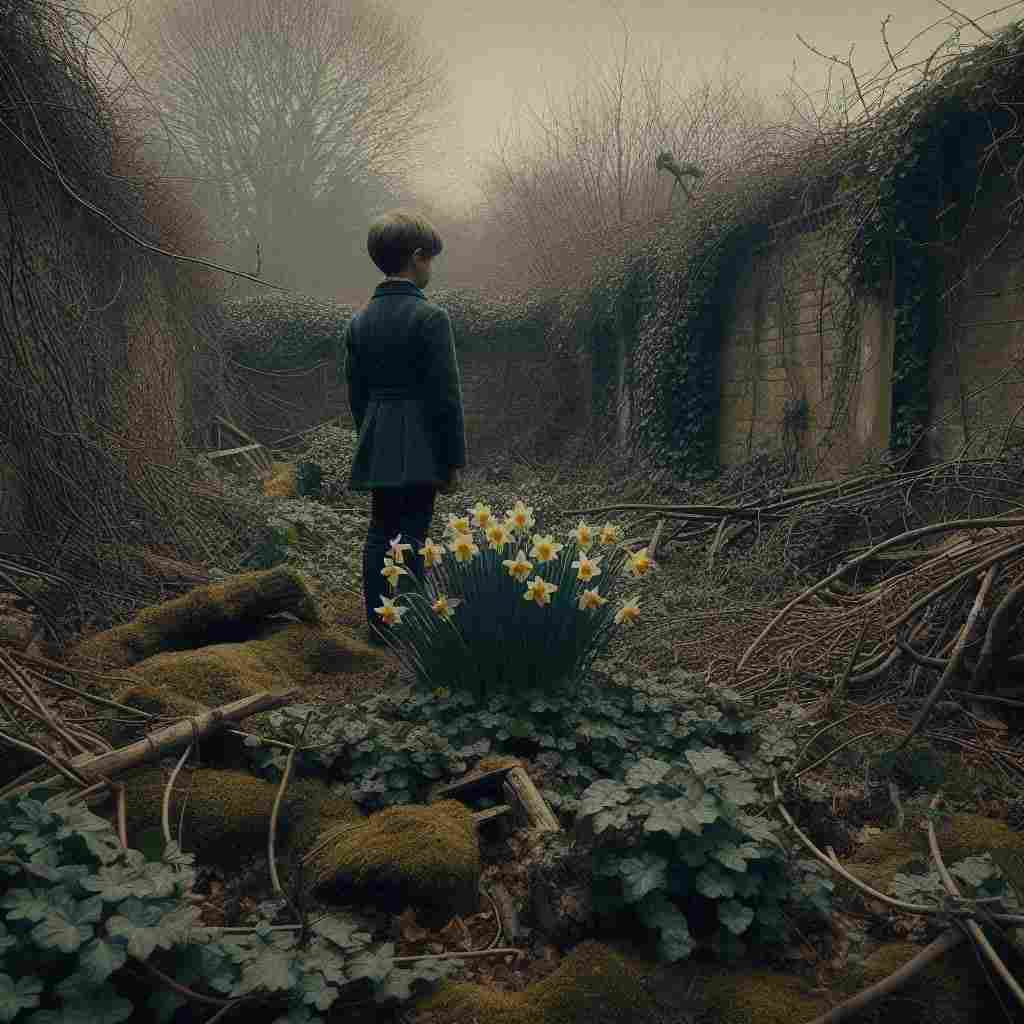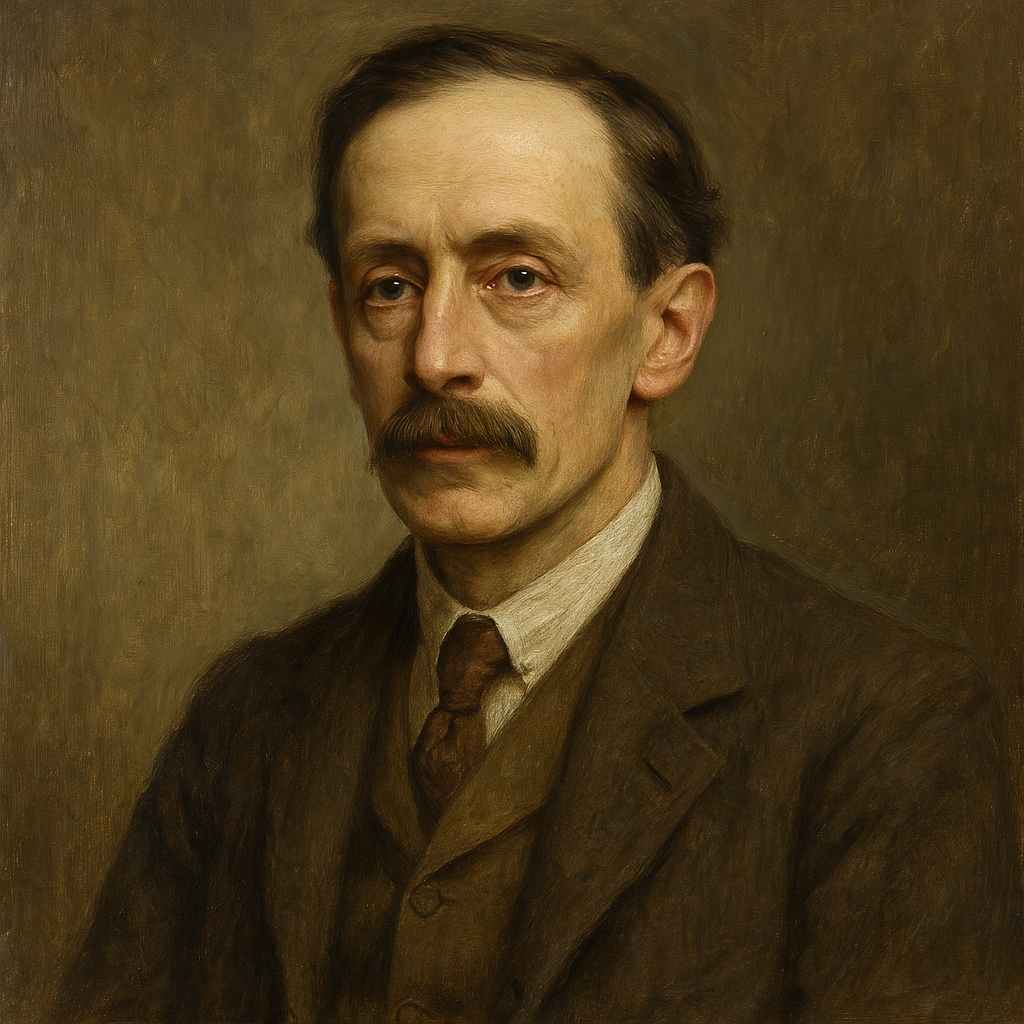The House That Was
Laurence Binyon
1869 to 1943

Of the old house, only a few crumbled
Courses of brick, smothered in nettle and dock,
Or a squared stone, lying mossy where it tumbled!
Sprawling bramble and saucy thistle mock
What once was firelit floor and private charm
Where, seen in a windowed picture, hills were fading
At dusk, and all was memory-coloured and warm,
And voices talked, secure from the wind's invading.
Of the old garden, only a stray shining
Of daffodil flames amid April's cuckoo-flowers,
Or a cluster of aconite mixt with weeds entwining!
But, dark and lofty, a royal cedar towers
By homely thorns: whether the white rain drifts
Or sun scorches, he holds the downs in ken,
The western vale; his branchy tiers he lifts,
Older than many a generation of men.
Laurence Binyon's The House That Was
Introduction
Laurence Binyon's "The House That Was" is a poignant exploration of time's inexorable march and the resilience of nature in the face of human impermanence. This sixteen-line poem, rich in imagery and emotional resonance, invites readers to contemplate the transient nature of human constructions juxtaposed against the enduring presence of the natural world. Through a masterful use of contrast, vivid descriptive language, and a subtle yet powerful emotional undercurrent, Binyon crafts a meditation on memory, decay, and the cyclical nature of existence.
Structure and Form
The poem is structured in two stanzas of eight lines each, following an irregular rhyme scheme (ABABCDCD EFEFGHGH). This form, while not adhering to a strict traditional pattern, provides a sense of balance and symmetry that mirrors the poem's thematic exploration of order and chaos, permanence and transience.
The lines alternate between iambic pentameter and trimeter, creating a rhythmic undulation that echoes the poem's central tension between stability and dissolution. This metrical variation also serves to emphasize key images and concepts, with the longer lines often carrying the weight of more complex descriptive passages, while the shorter lines punctuate the poem with sharp, evocative details.
Imagery and Symbolism
Binyon's imagery is particularly striking in its juxtaposition of the decayed remnants of human habitation with the vibrant, encroaching natural world. The first stanza focuses on the ruins of the house, described in terms that emphasize fragmentation and dissolution: "crumbled / Courses of brick," "a squared stone, lying mossy where it tumbled." These images of decay are immediately contrasted with the vigorous growth of wild plants: "nettle and dock," "Sprawling bramble and saucy thistle." The personification of the thistle as "saucy" infuses the natural world with a sense of irreverent triumph over human constructions.
The second stanza shifts focus to the remnants of the garden, where again, cultivated plants have given way to wild growth. The "stray shining / Of daffodil flames" and "cluster of aconite mixt with weeds entwining" present a picture of nature reclaiming and transforming the once-ordered space. This imagery serves as a powerful metaphor for the ways in which memory and time interact, with fragments of the past persisting amidst the overgrowth of the present.
The cedar tree stands as the poem's central symbol, embodying permanence and continuity in contrast to the ephemeral nature of human constructions. Described as "dark and lofty" and "royal," the cedar commands respect and awe. Its ability to withstand both "white rain" and scorching sun underscores its resilience, while its age—"Older than many a generation of men"—places human timescales in perspective.
Themes and Interpretation
The Passage of Time
At its core, "The House That Was" is a meditation on the passage of time and its effects on both the physical world and human memory. The title itself, with its use of past tense, immediately establishes a sense of loss and change. Throughout the poem, Binyon explores how time transforms familiar spaces, eroding human-made structures while allowing nature to flourish and evolve.
The contrast between the decaying house and the thriving wild plants serves as a poignant reminder of the impermanence of human endeavors. Yet, the poem does not present this transformation as entirely negative. There is a beauty in the way nature reclaims the space, suggesting a kind of renewal or rebirth amidst the decay.
Memory and Nostalgia
Binyon delves deeply into the realm of memory and nostalgia, particularly in the lines describing the house as it once was: "What once was firelit floor and private charm / Where, seen in a windowed picture, hills were fading / At dusk, and all was memory-coloured and warm." This vivid evocation of a cozy, intimate domestic scene stands in stark contrast to the current state of ruin, highlighting the power of memory to preserve what time has erased.
The phrase "memory-coloured" is particularly significant, suggesting that our recollections are not merely factual records but are tinted by emotion and the passage of time. This concept adds a layer of complexity to the poem's exploration of the past, implying that even as physical structures fade, they may be preserved—albeit transformed—in human memory.
Nature's Resilience and Indifference
Throughout the poem, nature is portrayed as a resilient and somewhat indifferent force. The wild plants that overtake the ruins of the house and garden are described in terms that suggest vitality and even a kind of joyful exuberance. The "saucy thistle" that mocks the remains of human habitation embodies this sense of nature's triumph over man-made order.
The cedar tree, in particular, stands as a testament to nature's enduring power. Its ability to withstand the elements and its vast lifespan place it outside the realm of human concerns. The tree's perspective—holding "the downs in ken, / The western vale"—suggests a broader, more timeless view of the landscape that transcends individual human experiences.
The Dialectic of Permanence and Change
Binyon's poem grapples with the tension between permanence and change, order and chaos. The house and garden, once symbols of human order imposed upon nature, have succumbed to time and the elements. Yet even in their decay, traces of their former structure remain, suggesting that nothing is ever truly lost, merely transformed.
This dialectic is perhaps most powerfully embodied in the image of the cedar tree. While it represents a kind of permanence, its very existence is predicated on constant change and growth. Its "branchy tiers" that lift skyward are the result of centuries of slow, incremental change, offering a different model of endurance than the static permanence humans often strive for in their constructions.
Conclusion
"The House That Was" is a masterful exploration of time, memory, and the relationship between human endeavors and the natural world. Through its vivid imagery, careful structure, and profound thematic depth, the poem invites readers to contemplate their own place in the grand sweep of time.
Binyon's work resonates with themes that have preoccupied poets for centuries—the brevity of human life, the power of memory, and the enduring beauty of nature. Yet he brings to these timeless concerns a uniquely early 20th-century sensibility, informed perhaps by the rapid changes and upheavals of his era.
Ultimately, "The House That Was" offers a nuanced view of decay and renewal, suggesting that while individual structures and lives may fade, they contribute to a larger, ongoing cycle of growth and transformation. In this way, Binyon's poem serves not only as an elegy for what has been lost but also as a celebration of the enduring processes of life and nature that continue long after we are gone.
This text was generated by AI and is for reference only. Learn more
Want to join the discussion? Reopen or create a unique username to comment. No personal details required!



Comments
No comments yet. Be the first to comment!